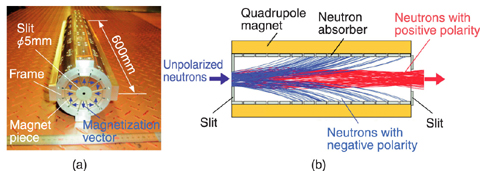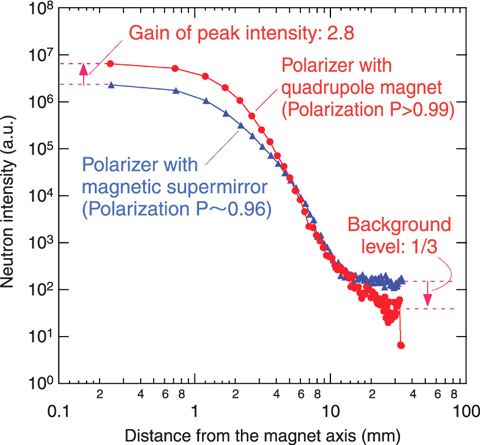
Fig.4-18 (a) Neutron polarizer with permanent quadrupole magnet, (b) Neutron trajectory in the quadrupole magnet

Fig.4-19 Experimental apparatus to focus and highly polarize neutrons

Fig.4-20 Neutron beam profile observed with a two-dimensional detector
A neutron is a valuable probe for the structural study of materials, which include light elements such as hydrogen atoms, or of magnetic materials, since it is scattered by nuclei and atomic magnetic moments. In order to increase the polarization of the neutron beam from about 96%, which can be obtained by a polarizer using magnetic supermirrors, to 99.9% and then apply the highly polarized neutrons to effective and precise analysis of the magnetic structure of magnetic materials, we have taken the lead in developing a neutron optical system to highly polarize and focus neutrons by using their property of being accelerated by a magnetic field gradient through the interaction between the magnetic field and the magnetic moment of neutron, and have evaluated the performance of this neutron optical system.
In the present neutron optical system we have used permanent quadrupole and sextupole magnets which produce quadrupole and sextupole magnetic fields in the beam path, to control the motion of neutron. A quadrupole magnet is superior for producing highly polarized neutrons by separating unpolarized neutrons spatially into two polarized components with positive and negative spin and so that one of these components can be selected (Fig.4-18). On the other hand, the sextupole magnet is suit to focus polarized neutrons finely at a focal point. Such fine polarization and focusing of neutrons is based on the structure of the multipole magnets, in which no materials scatters or absorbs neutrons in the beam path. We have evaluated the focusing performance of the polarized neutrons by the developed system at "JRR-3" as shown in Fig.4-19. The density of the neutrons polarized by the quadrupole magnet relative to the background level is about 10 times higher than that obtained by magnetic supermirrors as shown in Fig.4-20. We will make this developed system practical for the structural analysis of magnetic materials at JRR-3 and also improve it so that it is applicable to structural analysis using pulsed polychromatic neutrons at "J-PARC".
This basic study on the neutron control with the multipole magnet has been performed in collaboration with RIKEN and KEK. The present study was financially supported in part by the Special Coordination Fund for Promoting Science and Technology of MEXT.